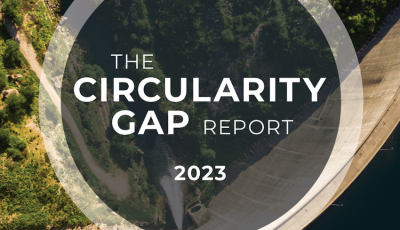 With a circular economy, we can fulfil people’s needs with just 70% of the materials we currently use—within the safe limits of the planet.
With a circular economy, we can fulfil people’s needs with just 70% of the materials we currently use—within the safe limits of the planet.
The launch event of the 6th Global Circularity Gap Report in Amsterdam highlighted the main findings of this year’s report. For me, these are the three main lessons from this gap report:
- Global circularity is still in decline. It went from 9.1% in 2018 to 7,2% now. This is just because the annual increase in primary extraction outpaces the growth of circular flows.
- With a circular economy, we can fulfil people’s ‘needs’ with just 70% of the materials we currently use. That will bring us back within the safe limits of the planet. The report proposes 16 interventions across 4 material intensive systems: food, built environment, consumables, mobility.
- The solutions are already out there. We don’t have to put our hopes on innovations still to come. Everything we need is already available.
For this edition of the gap report we looked into the changes in material wealth of nations. This confirmed that several high-income or shift countries continued to accumulate material wealth, without progressing (or even declining) on social, economic nor wellbeing indicators. Some of the low- and medium-income countries on the other hand showed remarkable progress, without (or with a declining) material footprint. This confirms that there is an issue of distribution, which manifests itself both within and between countries. That is also where the public debate is: whether it is about compensating incomes for inflation, taxing wealth, or enabling lower incomes to participate in the energy transition.
But how do we get there? For the circular economy to thrive, and all the 16 interventions to stand a chance against the vested interests of the linear economy, we also need to reduce inequality. This :
- Tax reform: tax pollution, extraction and wealth, rather than labour, in line with the Ex’tax narrative. This includes strengthening the capacity of revenue authorities in developing countries to track wealth, following the recommendations of the Oxfam ‘survival of the richest’ report.
- Investment in the commons: generous, high-quality public healthcare and education, affordable public housing and transportation. The argument is that ‘an abundant public affluence defuses the growth imperative’ (Less is more). Whereby I would argue that it is the growth of our global material footprint and waste flows which needs to be defused, since that growth drives the transgression of planetary boundaries.
- Economies which serve people’s needs, not the other way round. The gap report clearly articulates how we can reduce our material footprint while still providing more than enough for everyone. Its models leave out people’s ‘wants’ or desires, which is exactly the topic which the Oxfam report addresses.
The call for tax reform, climate action and the acceleration of the transition to a circular economy is louder than ever. The circularity gap report and the Oxfam report show important parts of the solutions. The also provice enough tangible recommendations to give future generations, and people which are disproportionally exposed to the downsides of our global value chains, back what is rightfully theirs.
Shifting Paradigms was part of the research team of this edition of the Global Circularity Gap Report.
Photo from Trace Hudson: https://www.pexels.com/nl-nl/foto/bevroren-landen-2400594/



